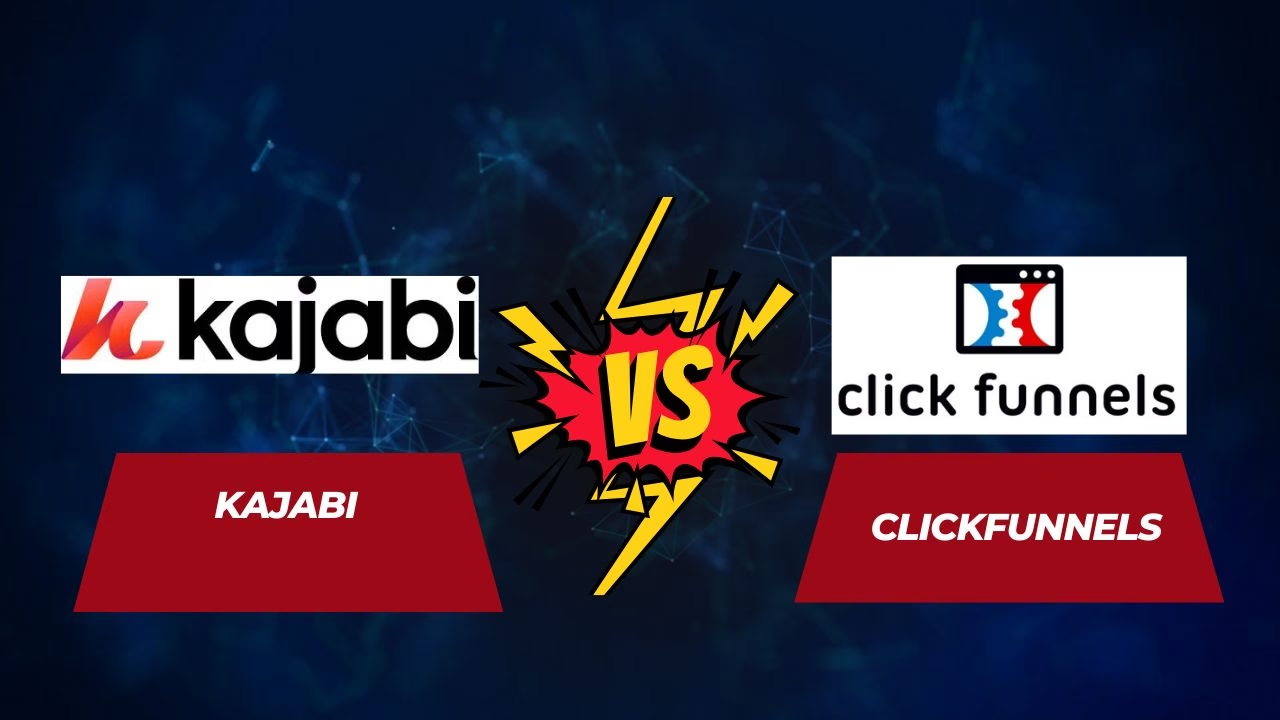Kajabi vs ClickFunnels: Compare core offerings and pricing to identify the perfect solution for your thriving digital business goals.
Table of Contents
Kajabi vs ClickFunnels: Unleash Your Online Business
1. Introduction to the Online Business Platform Landscape
The digital revolution has opened countless doors for aspiring entrepreneurs, coaches, and marketers who want to share their expertise with a global audience. You no longer need physical classrooms, big office spaces, or extensive overhead to grow a successful enterprise. Instead, you can use specialized platforms that provide the infrastructure to host content, manage payments, connect with your audience, and automate sales processes.
However, the sheer variety of choices can feel overwhelming. Each platform presents its own feature set, pricing, support structure, and third-party integrations. Some are dedicated solely to building marketing funnels, while others facilitate designing entire membership portals and online courses. Still others focus on creating dynamic websites with sophisticated automation tools.
Two of the most commonly discussed platforms among digital entrepreneurs are Kajabi and ClickFunnels. Both offer unique benefits but serve different purposes. This post aims to clarify their features, strengths, weaknesses, and potential use cases. By exploring Kajabi vs ClickFunnels in-depth, you can pinpoint which option truly fits your objectives.

2. An Overview of Kajabi and ClickFunnels
To make an informed decision, you need a foundational understanding of how each platform came into existence and what it aims to solve. Kajabi and ClickFunnels evolved in the online marketing space, responding to specific needs of digital entrepreneurs. While Kajabi was initially built to host and deliver knowledge-based products, ClickFunnels emerged to simplify the creation of sales and marketing funnels.
Understanding Kajabi
Kajabi started around 2010, focusing on the online education market. Its founders wanted to remove the technical barriers for experts who wanted to share their insights via membership sites or digital courses. Over time, Kajabi expanded its features to become an all-in-one solution for knowledge entrepreneurs. The platform now offers tools for:
- Course creation and hosting
- Membership site management
- Email marketing campaigns
- Landing pages and websites
- Payment processing
- Community features
One of Kajabi’s unique selling points is its emphasis on cohesive branding and seamless integration within a single interface. You can create a polished online learning environment that aligns with your business identity without relying heavily on external tools or endless plugins. For instance, you can build an entire website, design drip email sequences, track student progress, and manage sales, all within the Kajabi dashboard.
This ease of integration can be particularly beneficial if you are new to managing online content and prefer a centralized workspace. Kajabi emphasizes user-friendly systems, allowing you to focus on content creation and engagement rather than juggling multiple platforms.
Understanding ClickFunnels
ClickFunnels, founded by Russell Brunson in 2014, revolutionized the way businesses approach sales funnels. Prior to its launch, creating a funnel often required web developers, designers, marketing specialists, and a lot of fragmented tools. ClickFunnels combines these elements into a drag-and-drop system for building landing pages, sales pages, checkout pages, and upsell sequences.
The heart of ClickFunnels is the idea that a well-structured funnel can dramatically increase conversions. With a step-by-step approach, you can guide your audience through the entire customer journey—from the moment they land on a page to the final purchase (and even beyond). Key features include:
- Funnel templates for a variety of industries
- Drag-and-drop page editor
- Membership site options
- Upsell and downsell pages
- A/B testing tools
- Integrations with email marketing services
While ClickFunnels can be used to host courses and membership sites, the platform’s main focus is funnel building. If you prioritize marketing and sales conversions, you might lean toward ClickFunnels for its robust funnel-centric ecosystem.

3. Kajabi vs ClickFunnels: Key Features
When deciding between Kajabi and ClickFunnels, you will want to dive into the unique capabilities each offers. Although they share some features—like membership site creation and email marketing—they differ in depth, sophistication, and user experience. Below is a detailed look at the most prominent features you should examine.
Sales Funnel Functionality
Kajabi:
Kajabi’s funnel feature, often referred to as “Pipelines,” allows you to build marketing sequences that move customers through a particular journey. Pipelines have pre-built templates for webinars, product launches, and email sequences. They are designed to integrate smoothly with your courses or membership offerings. While these pipelines are straightforward, they may lack the extensive split-testing and advanced conversion tracking capabilities that some marketers desire.
ClickFunnels:
ClickFunnels excels in funnel-building, offering an array of templates for a wide range of businesses, from e-commerce stores to coaching agencies. The platform is lauded for its easy-to-implement upsell, downsell, and cross-sell pages, allowing you to capitalize on every stage of the customer journey. You can conduct A/B testing on different steps of the funnel, track metrics in real-time, and integrate third-party analytics tools to understand user behavior. The sales funnel functionality is more specialized and robust compared to most competitors.
Course Creation and Membership Sites
Kajabi:
Kajabi is often synonymous with online course hosting. You can create in-depth modules, drip content to students, and monitor user engagement. The platform provides a high-quality student experience with user-friendly navigation, community features, progress tracking, and customizable layouts. Membership sites are also intuitive to set up, enabling you to provide tiered offerings or an ongoing content subscription.
ClickFunnels:
You can build membership areas using ClickFunnels’ templates, but its features here are more modest. While you can protect content behind a login page and organize lessons in a sequence, you may find the course-building experience less sophisticated than on Kajabi. If your core focus is a membership or course platform, you might feel somewhat limited with ClickFunnels unless you integrate additional tools.
Website Building and Customization
Kajabi:
Kajabi includes a fully-fledged website builder with customizable themes. The templates look modern, and you can adjust colors, fonts, and layouts to align with your brand. If you prefer having your entire online presence under one roof, Kajabi’s website builder will come in handy. It lets you create multiple pages—homepage, about page, blog, and more—ensuring design consistency.
ClickFunnels:
ClickFunnels focuses on individual funnel pages more than a cohesive website. While you can technically piece together multiple funnel pages to resemble a full website, the process is less organic. Branding consistency may require additional work, and blogging is not a native feature. You might have to embed a blog from another platform or use custom code if having a blog is essential.
Email Marketing and Automation
Kajabi:
Kajabi’s built-in email marketing tool is crafted to integrate tightly with your course platform. You can set up automated campaigns based on triggers such as a new sign-up, a course completion milestone, or a cart abandonment. The email editor offers basic templates, personalization elements, and segmentation options. Analytics help you understand open rates and click-through rates, so you can refine your messaging.
ClickFunnels:
ClickFunnels includes an email service called Follow-Up Funnels (formerly Actionetics). With this feature, you can send targeted email series to users depending on their actions within your funnel. For instance, if someone clicks on a particular upsell page, you can automatically enroll them in a follow-up campaign. The segmentation capabilities are robust, letting you group contacts by multiple criteria. However, to fully unlock all email marketing features, you often need the higher-tier ClickFunnels subscription.
Integrations and Plugins
Kajabi:
Kajabi provides integrations with payment gateways like Stripe and PayPal, along with email marketing tools like MailChimp and ConvertKit (if you prefer external services). You can also integrate with third-party analytics systems such as Google Analytics. The native integrations may not be as numerous as you’ll find in more open-ended platforms, but Kajabi covers the most common business applications.
ClickFunnels:
ClickFunnels integrates with a wide range of third-party services—payment processors, email marketing platforms, and webinar tools. If you rely heavily on external software to manage your online business, you will likely find a smoother path with ClickFunnels. Additionally, ClickFunnels has a vibrant community of developers, offering plugins and scripts that add functionality, from countdown timers to advanced checkout options.
4. Ease of Use and Onboarding
No matter how powerful a platform might be, ease of use can make or break your experience. If a system has a steep learning curve, you may lose valuable time and resources trying to master it. Below is a breakdown of how Kajabi vs ClickFunnels compare in terms of user-friendliness.
- Kajabi’s approach: Kajabi organizes features in a neat dashboard, guiding you with step-by-step instructions for setting up courses, pipelines, and email sequences. Its user interface leans toward beginners or those who prefer not to tinker with too many advanced settings. The “Pipelines” concept is especially straightforward, making it easy to launch marketing campaigns without a developer. Even the website building feature is self-explanatory, relying on drag-and-drop sections.
- ClickFunnels’ approach: While the idea of building sales funnels might sound technical, ClickFunnels simplifies the process through templates and a drag-and-drop editor. However, some users feel that mastering all the different funnel types—like webinar funnels, product launch funnels, and membership funnels—takes time. The platform’s interface, though intuitive, requires some familiarity with marketing concepts (like upsells and order bumps). Once you grasp these fundamentals, creating funnels becomes more fluid.
In general, both Kajabi and ClickFunnels strive to empower you without needing advanced coding. If you are new to digital marketing or want a single place for everything, Kajabi’s cohesive environment might feel more welcoming. If you are marketing-savvy or don’t mind a slight learning curve for more powerful funnel features, ClickFunnels can be equally manageable.
5. Pricing Structures
Budget plays a significant role in your choice of platform. Whether you are an established business or a budding solopreneur, the cost of a tool must align with your projected returns. Below is a broad overview of Kajabi and ClickFunnels pricing plans. (Note that specifics can change, so always consult the official websites for up-to-date information.)
| Platform | Main Pricing Tiers | Key Features in Each Tier |
|---|---|---|
| Kajabi | Basic, Growth, Pro | – Basic: Allows for a limited number of products, pipelines, and contacts. – Growth: Scales up product creation and includes enhanced automation. – Pro: Offers the highest limits for products, contacts, and advanced tools like code editing. |
| ClickFunnels | Basic (ClickFunnels), Platinum (ClickFunnels), and higher-tier add-ons | – ClickFunnels Basic: Limited funnels, pages, and number of visitors. – ClickFunnels Platinum: Unlocks Follow-Up Funnels (advanced email marketing) and priority support. – Two Comma Club X and beyond: For higher-traffic or enterprise-level needs. |
Kajabi:
- Monthly fees typically start higher than some alternatives, reflecting its all-in-one nature.
- You can save by paying annually, which reduces the monthly cost.
- Offers a 14-day free trial (some promotions extend this).
ClickFunnels:
- Basic plan starts at a lower price point but includes fewer funnels and pages.
- Platinum plan expands features considerably, including advanced follow-up funnels and additional sub-users.
- Also offers a 14-day free trial to test the funnel-building environment.
When comparing plans, consider how many courses, funnels, and active customers you will have. Kajabi’s growth plan can be cost-effective if you operate multiple courses and use its built-in email system, negating the need for another marketing tool. Conversely, if your primary focus is building high-converting funnels, ClickFunnels’ Platinum plan might offer a better return on investment. Balance the number of tools you need to pay for outside the platform, as those costs add up quickly.
6. Customer Support and Resources
High-level customer support can be the difference between a smooth launch and a frustrating experience. Both platforms offer multiple support channels, but the depth of resources may vary.
- Kajabi: Provides 24/7 chat support on most plans, extensive training materials, and a community forum. Its Kajabi University offers video tutorials on various aspects of platform use, from creating a product to setting up advanced automations. If you like video-based learning, Kajabi’s structured courses can simplify the onboarding process.
- ClickFunnels: Offers email and chat support; higher-tier plans often receive priority. ClickFunnels also boasts a large community on social media, where you can find tutorials, success stories, and tips from experienced funnel builders. Additionally, the platform organizes live events and webinars to help users refine their marketing funnels. These events can be valuable if you want hands-on guidance from the ClickFunnels team and influential marketers.
In both cases, you will find a wealth of self-help articles, FAQs, and videos. If you prefer direct community engagement, you may appreciate ClickFunnels’ highly active Facebook group. If structured step-by-step training appeals to you, Kajabi’s official materials might be more satisfying.

7. Pros and Cons Table
Below is a quick reference table outlining the pros and cons of each platform, helping you visualize where each excels and where it might fall short.
| Factor | Kajabi | ClickFunnels |
|---|---|---|
| Pros | – Comprehensive course-building environment – Integrated website and branding – Robust membership features – Built-in email marketing – Seamless user experience for educators and learners | – Exceptional funnel-building tools – Extensive templates for various funnel types – Powerful upsell and A/B testing capabilities – Active community and support – Flexible integrations and plugins |
| Cons | – Higher pricing compared to standalone tools – Limited advanced split testing – Lacks extensive funnel templates | – Learning curve for advanced funnel features – Course hosting is not as robust – Website features are not as comprehensive – Can become expensive if you need additional add-ons |
| Ideal User | – Instructors, coaches, and course creators who want an all-in-one platform – Businesses that prefer minimal third-party tools | – Marketers and entrepreneurs focused heavily on sales funnels – Those who need advanced upsell, downsell, and conversion optimization features |
| Primary Focus | Online courses, memberships, and an integrated brand experience | High-converting sales funnels and specialized marketing campaigns |
8. Which One Should You Choose?
While both platforms have carved out significant niches in the online business world, your ultimate choice will hinge on your objectives. You should consider:
- The nature of your product or service: Are you a consultant with multiple courses to sell, or do you primarily rely on funnel-driven campaigns?
- Your technical comfort: Do you crave an all-in-one solution with minimal third-party integrations, or do you enjoy tinkering with marketing setups?
- Your budget and growth plans: Are you prepared to invest in a higher-priced all-in-one platform, or do you prefer a lower initial cost with potential add-ons as your funnel strategies evolve?
- The importance of branding and user experience: Does your brand demand a seamless educational environment, or is conversion optimization your main priority?
By weighing these factors, you can gauge which platform aligns most closely with your vision. Both Kajabi and ClickFunnels are formidable tools, but they are not identical. Identify the one that caters to your primary needs rather than looking for a one-size-fits-all approach.
9. Kajabi vs ClickFunnels in Different Scenarios
It is helpful to imagine specific business situations to understand better which platform might serve you best. Below are four hypothetical scenarios that highlight the strengths and weaknesses of Kajabi and ClickFunnels.
Scenario 1: You Need a Dedicated Sales Funnel Builder
Suppose your online venture involves selling high-ticket products, and you rely heavily on upsells, downsells, split testing, and conversion metrics. You run paid advertisements to attract cold leads, and you want to squeeze every possible conversion out of your funnel.
- Recommended Platform: ClickFunnels
- Why: You will benefit from its specialized funnels, advanced marketing analytics, and flexible testing capabilities.
Scenario 2: You Want an All-in-One Course Creation Tool
You might be an author, coach, or entrepreneur who has multiple lessons, resources, and community features to share. You value a smooth student experience with an integrated website, no separate logins for different systems, and a consistent brand feel.
- Recommended Platform: Kajabi
- Why: You can create courses, host membership content, and manage email marketing in one place. You also gain a polished website builder for a unified brand presence.
Scenario 3: You Require Customizable Marketing Tools
Maybe your business requires a combination of strong marketing funnels and robust course hosting. You also plan to integrate with advanced analytics software or want total flexibility in connecting multiple external services.
- Recommended Platform: ClickFunnels for marketing + Additional integrations (e.g., a separate course hosting service if needed)
- Why: ClickFunnels has a powerful funnel ecosystem with many integration points. You can still utilize third-party LMS (Learning Management System) tools for your course content.
Scenario 4: You Prioritize Membership Community Features
If maintaining an engaged member base is essential—through forums, live Q&A, or direct messaging among members—your platform choice should offer solid community features. A frictionless environment keeps users involved and fosters loyalty.
- Recommended Platform: Kajabi
- Why: Kajabi’s community function, combined with course hosting and email marketing, allows you to create an interactive membership experience with minimal hassle.
10. Additional Tips for Making Your Final Decision
Selecting a platform is a substantial investment, both financially and timewise. Here are additional pointers to ensure you make the most informed choice:
- Test Each Platform Using a Free Trial
Both Kajabi and ClickFunnels offer trial periods, so use this time to build a test funnel or course. Observe which interface feels more intuitive and whether the available features match your needs. - Map Out Your Customer Journey
Before committing, draft a high-level overview of your ideal customer journey. Identify touchpoints where you need marketing automations, checkouts, or membership gating. Then, see how each platform handles these requirements. - Consider Your Growth Trajectory
If you envision rapid growth, analyze which platform can easily scale with you. Check the maximum number of courses, funnels, or contacts allowed in each plan. Also, estimate your future traffic levels to ensure your chosen plan can handle the load. - Review Analytics and Reporting
Good reporting helps you refine your strategies. Check how each platform reports on sales, opens, clicks, and user behavior. A comprehensive analytics dashboard can save you from integrating too many external tools. - Consult Your Network or Community
If you know other entrepreneurs in the same niche, ask them about their experiences with Kajabi or ClickFunnels. Direct feedback can shed light on any hidden pitfalls or highlight unexpected benefits. - Check for Additional Costs
Remember that some plans require you to pay for separate email marketing tools, domain hosting, or design assets. Calculate potential monthly and annual expenses to avoid surprises down the line.
11. Final Thoughts on Kajabi vs ClickFunnels
When choosing between Kajabi and ClickFunnels, you are essentially deciding between two different philosophies of running an online business. Kajabi champions an all-in-one approach, excelling at course creation, membership management, and cohesive branding. If your main products are educational in nature and you value a unified platform, you might gravitate toward Kajabi.
On the other hand, ClickFunnels stands as a dedicated sales funnel powerhouse. Its templates, conversion-oriented features, and robust integrations cater to marketers who want to optimize every step of the customer acquisition process. Although you can create membership sites, the platform truly shines when you dedicate it to building intricate funnels with upsells and cross-sells.
In many cases, your choice might depend on whether you see yourself primarily as a content creator or a marketer. Of course, both platforms enable some level of each function. Kajabi has improved its funnels, and ClickFunnels has membership site capabilities. Yet, each solution remains strongest in its original domain.
If you aim to position yourself as an authoritative educator or community builder, Kajabi can support your vision with less reliance on external applications. If your income model relies heavily on optimizing funnels and scaling conversions, ClickFunnels will likely serve you better.
Ultimately, there is no universal best option. Only you can determine which tool delivers the right blend of functionalities for your goals. By evaluating everything from pricing to design flexibility, you can make a clear-headed choice that will support your business in the long run. Remember, it’s not about the trendiest product or the biggest user base. It’s about finding the platform that aligns with your unique strengths, target audience, and long-term vision.













